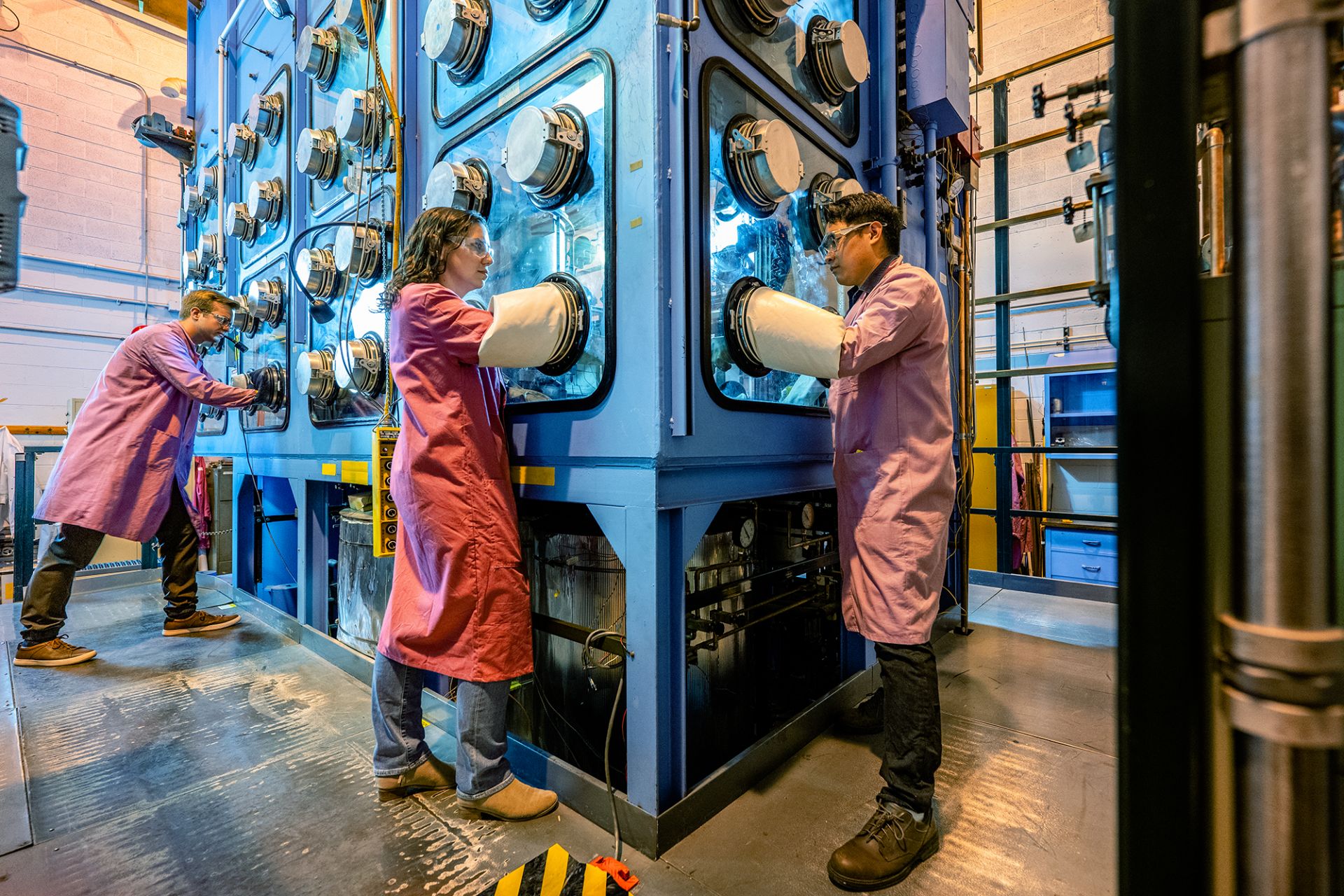At NRC headquarters are (from left) UUSA’s Gerard Poortman, Wyatt Padgett, Lisa Hardison, and Paul Lorskulsint (seated), with the NRC’s James Downs (seated), Shana Helton, Kimyata Morgan-Butler, John Lubinski, and Johnathan Rowley. (Photo: Urenco USA)
Just one day after Urenco USA (UUSA) was picked by the Department of Energy as one of six contractors eligible to compete for future low-enriched uranium task orders, the Nuclear Regulatory Commission on December 11 formally approved the company’s license amendment request to boost uranium enrichment levels at its Eunice, N.M., enrichment facility to 10 percent fissile uranium-235—up from its current limit of 5.5 percent.
(Image: General Atomics Electromagnetic Systems)
General Atomics Electromagnetic Systems (GA-EMS) announced last week that unfueled test rods featuring the company’s SiGA fuel cladding—made of a silicon carbide composite material—successfully survived 120 days of irradiation in the Advanced Test Reactor (ATR) at Idaho National Laboratory.
A subset of the Deimos experiment team. (Photo: LANL)
Los Alamos National Laboratory researchers have performed a critical experiment using high-assay low-enriched uranium (HALEU) TRISO fuel. It is the nation’s first criticality safety experiment using HALEU fuel in more than 20 years. On November 21, LANL announced the work of its Deimos team, which earlier this year carried out an experiment at the National Criticality Experiments Research Center (NCERC), operated by LANL at the Nevada National Security Site.
INL team removing and staging irradiated ANEEL fuel rodlets in the ATR canal. (Photo: Clean Core)
At INL's Fuel Conditioning Facility, spent nuclear fuel material is being recycled into fuel for Oklo's commercial Aurora Powerhouse deployment at INL. (Photo: INL)
Oklo Inc. announced yesterday that a safety design report for the Aurora fuel fabrication facility the company plans to build at Idaho National Laboratory has the approval of the Department of Energy. At the facility, Oklo plans to use high-assay low-enriched uranium (HALEU) that has been recovered from used Experimental Breeder Reactor-II fuel to produce fuel for its first planned microreactor—dubbed Aurora—which is also set for deployment at INL.
The EBR-II dome, site of the DOME advanced reactor test bed. (Photo: INL)
Representatives of Urenco, the United Kingdom, the United States, Germany, the Netherlands, and the IAEA gathered at Urenco’s Capenhurst site. (Photo: Urenco)
Uranium enricher Urenco welcomed representatives from the International Atomic Energy Agency to an August 19 event to mark the creation of an IAEA Centre of Excellence for Safeguards and Non-Proliferation at its Capenhurst, England, site. Representatives of the three nations with ownership stakes in Urenco—the United Kingdom, the Netherlands, and Germany—were joined by representatives from the United States, where Urenco also operates an enrichment plant. Urenco expects the new center to be fully operational in 2025.
Westinghouse ADOPT fuel pellets. (Photo: Westinghouse)
Westinghouse Electric Company announced Aug. 8 that it has completed the first pressing of ADOPT nuclear fuel pellets at the company’s Springfields Fuel Manufacturing Facility in the United Kingdom. The pellets, which can contain up to 8 percent uranium-235 by weight, are destined for irradiation testing in Southern Nuclear’s Vogtle-2 pressurized water reactor.
Urenco’s Capenhurst enrichment site in the U.K. (Photo: Urenco)
A plan to build up a high-assay low-enriched uranium fuel cycle in the United Kingdom to support the deployment of advanced reactors is still in place after the Labour party was voted to power on July 4, bringing 14 years of conservative government to an end. A competitive solicitation for grant funding to build a commercial-scale HALEU deconversion facility opened days before the election, and the support of the new government was confirmed by a set of updates on July 19. But what does the U.K. HALEU program entail, and how does it differ from the U.S. HALEU Availability Program?
Engineers in Argonne’s Chemical and Fuel Cycle Technologies Division. (Photo: Argonne National Laboratory)
Oklo Inc. announced that it has completed the first end-to-end demonstration of its advanced fuel recycling process as part of an ongoing $5 million project in collaboration with Argonne and Idaho National Laboratories. Oklo’s goal: scaling up its fuel recycling capabilities to deploy a commercial-scale recycling facility that would increase advanced reactor fuel supplies and enhance fuel cost effectiveness for its planned sodium fast reactors.
SiGA woven silicon carbide nuclear fuel cladding. (Photo: DOE)
Because of its hardness and its hardiness in the face of high temperatures, silicon carbide has been used for industrial purposes for decades. It has proven its worth as a key component of tiny TRISO fuel particles. But SiC has a weakness—in its pure form it is too brittle for use in structural components, such as 12-foot-long light water reactor fuel cladding tubes.
Framatome’s fuel fabrication facility in Richland, Wash. (Photo: Framatome)
TerraPower announced May 29 that it will work with Framatome North America to fund the high-assay low-enriched uranium (HALEU) metallization pilot plant that Framatome is building at its fuel fabrication facility in Richland, Wash. A successful demonstration of Framatome’s capability of converting enriched uranium oxide to HALEU metal will “support the development of the domestic HALEU supply chain,” both companies say.














